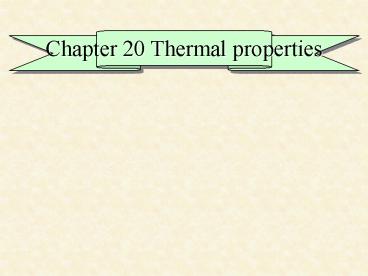Chapter 20 Thermal properties - PowerPoint PPT Presentation
1 / 20
Title: Chapter 20 Thermal properties
1
Chapter 20 Thermal properties
2
???(Heat Capacity)
q
Thermal energy
3
(No Transcript)
4
Heat Capacity
Indicative of a materials ability to absorb
heat from the external surroundings
5
(No Transcript)
6
Other heat capacity Contributions
Other energy-absorptive mechanism in a solid
Electronic Contribution (Metals)
Free electrons absorb energy by increasing their
kinetic energy
20-1-3
7
Thermal Expansion
(Tf - To)
T
Interatomic distance
0
Potential energy
r3
r4
r5
r2
r1
Vibration energies
E5
E4
E3
E2
E1
r0
(a)
20-2-1
8
Metals
for common metals
5 - 25
(1 for Fe-Ni, Fe-Co alloys)
isotropic
lt
for most ceramics
Ceramics
0.5-15
( Relatively strong interatomic bonding forces)
anisotropic
ltlt
Polymers
50-300
( Secondary intermolecular bonds are weak, and
there is a minimum of Cross-linking)
20-2-2
9
Thermal Conductivity
Heat flux q
Thermal Conductivityw/mk
Heat conduction
Thermal energy carrier
k kl ke
(Photon, free electron, photon)
20-3-1
10
Phonon
The thermal energy associated with phonons or
lattice waves is transported in the direction of
their motion. The contribution results from
a net movement of phonons from high- to
low-temperature regions of a body across which a
temperature gradient exists.
kl
11
Free electron
Free or conducting electrons participate in
electronic thermal conduction. To the free
electrons in a hot region of the specimen is
imparted a gain in kinetic energy. They then
migrate to colder areas, where some of this
kinetic energy is transferred to the atoms
themselves (as vibrational energy) as a
consequence of collisions with phonons or other
imperfections in the crystal. The relative
contribution of ke to the total thermal
conductivity increases with increasing free
electron concentrations, since more electrons are
available to participate in this heat
transference process.
12
(No Transcript)
13
(No Transcript)
14
Metals
In high-purity metals, the electron mechanism
of heat transport is much more efficient than the
phonon contribution because electrons are not as
easily scattered as phonons and have higher
velocities. Furthermore, metals are extremely
good conductors of heat because relatively large
numbers of free electrons exist that participate
in thermal conduction.
15
Ceramics
Nonmetallic materials are thermal insulators
in as much as they lack large numbers of free
electrons. Thus the phonons are primarily
responsible for thermal conduction is much
smaller than . Again, the phonons are not as
effective as free electrons in the transport of
heat energy as a result of the very efficient
phonon scattering by lattice imperfections.
ke
kl
16
(No Transcript)
17
(1) Stresses Resulting from Restrained Thermal
Expansion Contraction
E E
( Tf-T0 )
- E
18
(No Transcript)
19
(3) Thermal Shock of Brittle Materials
For ductile metals and polymers, alleviation of
thermally induced stresses may by accomplished
by plastic deformation. However, the
nonductility of most ceramics enhances the
possibility of brittle fracture from these
stresses.
Rapid cooling of a brittle body is more likely
or inflict such thermal shock than heating,
since the induced surface stresses are tensile.
20
Thermal Shock Resistance
Thermal Shock Resistance(TSR) f ( , , k
, ... )
TSR
E
??
,
,
,
E
,
CaO, Na2O
?
Pyrex glass ( 3 10-6)
Soda-lime glass ( 9 10-6)































